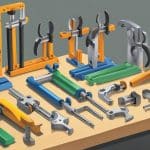Types Of Roof Vents
Roof vents are an essential component of any roofing system. They help to regulate the temperature and humidity levels in the attic, preventing moisture buildup and mold growth. Proper roof ventilation can also improve the energy efficiency of a home, reducing the need for air conditioning and lowering energy bills. In this article, we will explore the different types of roof vents available, their benefits and drawbacks, and how to choose the best one for your home.
Fundamentals of Roof Ventilation
Before delving into the types of roof vents, it is important to understand the fundamentals of roof ventilation. The primary function of roof vents is to allow air to circulate through the attic space. This helps to regulate the temperature and humidity levels, preventing moisture buildup and mold growth. Proper ventilation can also improve energy efficiency by reducing the need for air conditioning.
Types of Roof Vents
There are many different types of roof vents available, each with its own set of benefits and drawbacks. Some of the most common types include ridge vents, soffit vents, gable vents, and turbine vents. Ridge vents are installed at the peak of the roof and allow hot air to escape, while soffit vents are installed under the eaves and allow cooler air to enter. Gable vents are installed on the sides of the roof, while turbine vents use wind power to create a vacuum effect that draws hot air out of the attic.
Fundamentals of Roof Ventilation

Importance of Ventilation
Proper roof ventilation is essential to maintain a healthy and comfortable living environment. Without proper ventilation, the attic space can become extremely hot and humid, leading to the buildup of moisture and heat. This can cause damage to the roof and insulation, increase energy bills, and even lead to the formation of condensation and mold.
Ventilation Principles
The basic principle of ventilation is to allow fresh air to enter the attic space and exhaust hot air out of the roof. The most effective way of achieving this is through a combination of soffit vents and ridge venting. Soffit vents are located under the eaves of the roof and allow cool air to enter the attic space. Ridge vents are installed at the peak of the roof and allow hot air to escape. This creates a natural airflow that helps to regulate the temperature and moisture levels in the attic space.
It is important to note that proper roof ventilation is not just about adding more vents. It is about creating a balanced system that allows for adequate airflow while preventing the buildup of excess moisture. This requires careful consideration of the size and placement of vents, as well as the insulation levels in the attic space.
In summary, proper roof ventilation is essential for maintaining a healthy and comfortable living environment. It helps to regulate temperature and moisture levels in the attic space, prevent damage to the roof and insulation, and reduce energy bills. By understanding the principles of ventilation and implementing a balanced system of soffit and ridge venting, homeowners can ensure that their roofs are properly ventilated and protected from the damaging effects of excess moisture and heat.
Types of Roof Vents
When it comes to roof ventilation, there are three main types of vents: intake vents, exhaust vents, and specialized vent types. Each of these vent types serves a specific purpose in maintaining proper attic ventilation and preventing issues such as moisture buildup, mold growth, and roof damage.
Intake Vents
Intake vents are typically located along the soffit or eave of the roof and allow cool, fresh air to enter the attic space. This helps to regulate the temperature and humidity levels inside the attic and prevent moisture buildup. Common types of intake vents include soffit vents, box vents, and gable vents.
Soffit vents are installed along the underside of the roof’s overhang and allow air to enter the attic through small perforations. Box vents, also known as roof vents or static vents, are installed on the roof and allow air to enter the attic through a vented box. Gable vents are installed on the sides of the roof and allow air to enter the attic through a vented opening.
Exhaust Vents
Exhaust vents are typically located near the top of the roof and allow warm, moist air to exit the attic space. This helps to prevent moisture buildup and maintain proper ventilation. Common types of exhaust vents include ridge vents, turbine vents, power vents, and static vents.
Ridge vents are installed along the roof’s ridge and allow air to exit the attic through a vented opening. Turbine vents use wind power to draw air out of the attic and are installed on the roof. Power vents, also known as attic fans, use electricity to draw air out of the attic and are installed on the roof or gable. Static vents are similar to box vents and are installed on the roof to allow air to exit the attic through a vented opening.
Specialized Vent Types
In addition to intake and exhaust vents, there are also specialized vent types that are designed for specific roofing situations. These include roof louvers, cupola vents, fascia vents, off ridge vents, hip vents, and drip edge vents.
Roof louvers are installed on the roof and allow air to enter or exit the attic through a louvered opening. Cupola vents are installed on the roof’s cupola and allow air to enter or exit the attic through a vented opening. Fascia vents are installed along the roof’s fascia and allow air to enter or exit the attic through a vented opening.
Off ridge vents are similar to ridge vents but are installed off-center on the roof’s ridge. Hip vents are installed on the roof’s hips and allow air to exit the attic through a vented opening. Drip edge vents are installed along the roof’s drip edge and allow air to enter or exit the attic through a vented opening.
Overall, proper attic ventilation is crucial for maintaining the health and longevity of a roof. Understanding the different types of roof vents and their purposes can help homeowners make informed decisions when it comes to choosing the right ventilation system for their home.
Benefits and Drawbacks of Different Vents
When it comes to roof vents, each type has its own set of benefits and drawbacks. In this section, we’ll go over the performance and efficiency, durability and maintenance, and aesthetic and design considerations of different vents.
Performance and Efficiency
The performance and efficiency of a roof vent is an important consideration for homeowners. Ridge vents are a popular choice because they provide excellent ventilation and are energy efficient. Soffit vents are also a good option, as they allow cool air to enter the attic and push hot air out through the ridge vent.
Powered attic vents and solar powered vents are also available, but they can be less efficient than ridge and soffit vents. While they can be effective at removing hot air from the attic, they can also draw conditioned air out of the house, which can increase energy costs.
Durability and Maintenance
The durability and maintenance of a roof vent is another important consideration. Ridge vents and soffit vents are low maintenance and can last for decades with proper installation. Powered attic vents and solar powered vents, on the other hand, may require more maintenance and have a shorter lifespan.
It’s also important to consider the quality and warranty of the vent. Investing in a high-quality vent with a good warranty can save homeowners money in the long run.
Aesthetic and Design Considerations
Finally, homeowners should consider the aesthetic and design considerations of different roof vents. Ridge vents and soffit vents are often preferred because they are hidden from view, while powered attic vents and solar powered vents can be more noticeable.
Homeowners may also want to consider eco-friendly options, such as energy efficient and solar powered vents, which can help reduce their carbon footprint. However, it’s important to weigh the pros and cons of each option before making a decision.
Installation and Maintenance
Professional Installation
When it comes to installing roof vents, it’s always recommended to hire a professional roofing contractor. A professional installation ensures that the job is done correctly, which can prevent issues like roof leaks and premature wear and tear. Roofing contractors have the necessary tools and equipment to get the job done right, and they have the experience to troubleshoot any issues that may arise during the installation process.
DIY Considerations
If you’re considering a DIY installation, it’s important to be aware of the risks involved. A poorly installed roof vent can lead to water leaks, which can cause significant damage to your roof sheathing or decking. It’s also important to consider the type of attic ventilation system you have and whether a roof vent is the best option for your home. If you’re unsure about the installation process or whether a roof vent is the best option for your attic ventilation needs, it’s best to consult with a professional roofing contractor.
Maintenance Tips
Once your roof vents are installed, it’s important to keep up with regular maintenance to ensure they continue to function properly. Here are a few maintenance tips to keep in mind:
- Check your roof vents regularly for any signs of damage or wear and tear. If you notice any issues, it’s important to address them as soon as possible to prevent further damage.
- Clear any debris or obstructions from your roof vents. Leaves, twigs, and other debris can accumulate in your roof vents over time, which can prevent proper airflow and ventilation.
- Inspect your attic ventilation system regularly to ensure it’s functioning properly. Your roof vents are just one part of your attic ventilation system, so it’s important to make sure everything is working together to keep your attic properly ventilated.
By following these maintenance tips and addressing any issues promptly, you can help ensure that your roof vents continue to function properly and protect your home from damage.
Advanced Considerations
Technological Innovations
Roof vents have come a long way in terms of technology. Manufacturers such as GAF and Owens Corning have developed advanced ventilation systems that can help regulate temperature and humidity in the attic. These systems can be integrated with humidistats that automatically adjust the ventilation based on the humidity levels in the attic.
Another innovation in roof vents is the use of solar energy to power the ventilation system. These systems are designed to work even in frigid temperatures, and can help prevent ice dams from forming on the roof. They are also environmentally friendly, as they do not require electricity to operate.
Environmental Impact
Proper ventilation is essential for preventing mold, mildew, and wood rot in the attic. However, traditional roof vents can have a negative impact on the environment. Active ventilation systems, such as electric-powered fans, consume a lot of electricity. This can lead to increased energy consumption and higher utility bills.
Passive ventilation systems, such as ridge vents and soffit vents, are more environmentally friendly. They do not require electricity to operate, and can help reduce the carbon footprint of a home.
Building Codes and Regulations
Building codes and regulations vary depending on the location of the home. It is important to consult with local building officials to ensure that the ventilation system meets the requirements of the area. Some areas may require specific types of roof vents, such as wind turbines or static vents.
Financing options may also be available for homeowners looking to upgrade their ventilation system. Some government programs offer incentives for homeowners who install energy-efficient roof vents. It is important to research these options and determine if they are available in the area.
In conclusion, advanced considerations such as technological innovations, environmental impact, and building codes and regulations should be taken into account when choosing a roof vent system. Homeowners should consult with professionals and do their research to ensure that they are making an informed decision.






